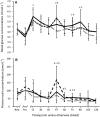A comparison of isomaltulose versus maltodextrin ingestion during soccer-specific exercise
- PMID: 28929343
- PMCID: PMC5700989
- DOI: 10.1007/s00421-017-3719-5
A comparison of isomaltulose versus maltodextrin ingestion during soccer-specific exercise
Erratum in
-
Correction to: A comparison of isomaltulose versus maltodextrin ingestion during soccer-specific exercise.Eur J Appl Physiol. 2018 Jan;118(1):223. doi: 10.1007/s00421-017-3750-6. Eur J Appl Physiol. 2018. PMID: 29147772 Free PMC article.
Abstract
Purpose: The performance and physiological effects of isomaltulose and maltodextrin consumed intermittently during prolonged soccer-specific exercise were investigated.
Methods: University soccer players (n = 22) performed 120 min of intermittent exercise while consuming 8% carbohydrate-electrolyte drinks (equivalent to ~ 20 g h-1) containing maltodextrin (Glycaemic Index: 90-100), isomaltulose (Glycaemic Index: 32) or a carbohydrate-energy-free placebo in a manner replicating the practices of soccer players (i.e., during warm-up and half-time). Physical (sprinting, jumping) and technical (shooting, dribbling) performance was assessed.
Results: Blood glucose and plasma insulin (both P < 0.001) concentrations varied by trial with isomaltulose maintaining > 13% higher blood glucose concentrations between 75 and 90 min versus maltodextrin (P < 0.05). A decline in glycaemia at 60 min in maltodextrin was attenuated with isomaltulose (-19 versus -4%; P = 0.015). Carbohydrates attenuated elevations in plasma epinephrine concentrations (P < 0.05), but isomaltulose proved most effective at 90 and 120 min. Carbohydrates did not attenuate IL-6 increases or reductions in physical or technical performances (all P > 0.05). Ratings of abdominal discomfort were influenced by trial (P < 0.05) with lower values for both carbohydrates compared to PLA from 60 min onwards.
Conclusions: Although carbohydrates (~ 20 g h-1) did not attenuate performance reductions throughout prolonged soccer-specific exercise, isomaltulose maintained higher blood glucose at 75-90 min, lessened the magnitude of the exercise-induced rebound glycaemic response and attenuated epinephrine increases whilst maintaining similar abdominal discomfort values relative to maltodextrin. When limited opportunities exist to consume carbohydrates on competition-day, low-glycaemic isomaltulose may offer an alternative nutritional strategy for exercising soccer players.
Keywords: Carbohydrate; Extra-time; Football; Half-time; Rebound hypoglycaemia.
Conflict of interest statement
Ethical standards
This study was approved by an appropriate ethics committee and has therefore been performed in accordance with the ethical standards laid down in the 1964 Declaration of Helsinki and its later amendments. All participants provided written informed consent prior to any participation.
Conflict of interest
Authors MR and ES received a Grant from BENEO GmbH to complete this work. The study results and data contained in this publication have been developed by and/or for BENEO of which authors AH and ST are employees. BENEO reserves the exclusive right to use the results and data for possible Health Claim requests.
Figures


References
Publication types
MeSH terms
Substances
LinkOut - more resources
Full Text Sources
Other Literature Sources
Medical

